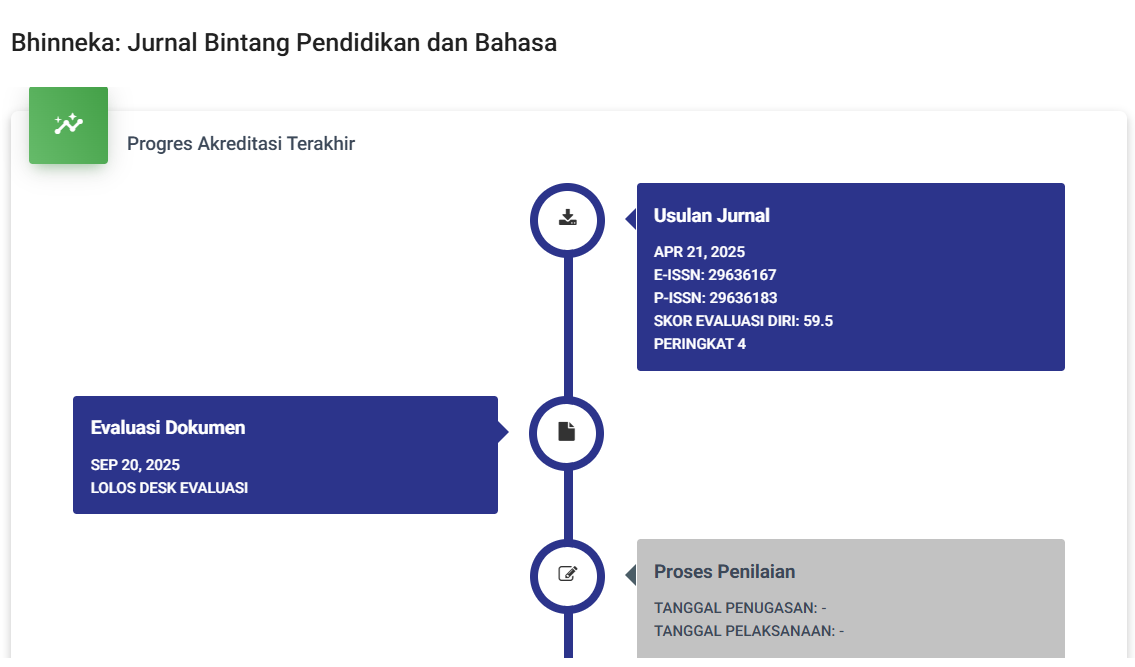Hubungan Gelombang Cahaya Lampu dan Cahaya Biru dengan Kualitas Tidur Remaja Dewasa
DOI:
https://doi.org/10.59024/bhinneka.v2i1.621Keywords:
Blue light, Lamp light, Melatonin hormone, Sleep quality, Circadian cycleAbstract
Sleep is a crucial part of the human circadian cycle. The quality and quantity of sleep significantly influence various aspects of health, both physical and psychological. The hormone melatonin, which plays a vital role in sleep regulation, is produced as the intensity of light received by the eyes decreases. Currently, the use of lights and electronic devices emitting blue light is widespread, especially among teenagers to adults. This blue light can interfere with the production of melatonin, potentially disrupting sleep quality and patterns. In this age group, most are active students with busy schedules. This study uses a sequential explanatory design approach, combining quantitative and qualitative questionnaires to collect data and measure the impact of light on sleep duration and patterns. The respondents of this study were 71 people, coming from various universities and different study programs in Bandung City, ranging in age from 18 to 25 years. The research data results show that 38.6% of respondents experience sleep disturbances when the light is on, impacting sleep quality. Conversely, sleep quality improvement occurs in 81.4% of respondents when sleeping with the light off. The use of night mode on electronic devices, designed to reduce blue light emissions, positively impacts sleep quality, as felt by 38% of the 67.1% of respondents who use the night mode feature.
References
Blume, C., Garbazza, C., & Spitschan, M. (2019). Effects of light on human circadian rhythms, sleep and mood. Somnologie : Schlafforschung Und Schlafmedizin = Somnology : Sleep Research and Sleep Medicine, 23(3), 147–156. https://doi.org/10.1007/s11818-019-00215-x
Brown, T. M., Brainard, G. C., Cajochen, C., Czeisler, C. A., Hanifin, J. P., Lockley, S. W., … Wright, K. P. (2022). Recommendations for daytime, evening, and nighttime indoor light exposure to best support physiology, sleep, and wakefulness in healthy adults. PLOS Biology, 20(3), e3001571. https://doi.org/10.1371/journal.pbio.3001571
Cajochen, C., Münch, M., Kobialka, S., Kräuchi, K., Steiner, R., Oelhafen, P., … Wirz-Justice, A. (2005). High Sensitivity of Human Melatonin, Alertness, Thermoregulation, and Heart Rate to Short Wavelength Light. The Journal of Clinical Endocrinology & Metabolism, 90(3), 1311–1316. https://doi.org/10.1210/jc.2004-0957
Chang, A.-M., Aeschbach, D., Duffy, J. F., & Czeisler, C. A. (2015). Evening use of light-emitting eReaders negatively affects sleep, circadian timing, and next-morning alertness. Proceedings of the National Academy of Sciences, 112(4), 1232–1237. https://doi.org/10.1073/pnas.1418490112
Chellappa, S. L., Steiner, R., Blattner, P., Oelhafen, P., Götz, T., & Cajochen, C. (2011). Non-visual effects of light on melatonin, alertness and cognitive performance: Can blue-enriched light keep us alert? PLoS ONE, 6(1). https://doi.org/10.1371/journal.pone.0016429
Del Brutto, O. H., Mera, R. M., Rumbea, D. A., Sedler, M. J., & Castillo, P. R. (2023). Poor sleep quality increases mortality risk: A population-based longitudinal prospective study in community-dwelling middle-aged and older adults. Sleep Health. https://doi.org/10.1016/j.sleh.2023.10.009
Deslaranti, Rochmani, S., & Mei Winarni, L. (2022). HUBUNGAN PENGGUNAAN CAHAYA LAMPU SAAT TIDUR DENGAN KUALITAS TIDUR PADA SISWA SISWI KELAS XI JURUSAN IPS DI SMAN 25 KAB. TANGERANG. ARTIKEL PENELITIAN Jurnal Kesehatan, 11(2). https://doi.org/10.37048/kesehatan.v11i2.468
Feriani, D. A. (2020). HUBUNGAN KUALITAS TIDUR DENGAN KONSENTRASI BELAJAR SISWA KELAS X TKJ 2 DAN XI TKJ 1 DI SMK NEGERI 1 JIWAN KABUPATEN MADIUN. Retrieved from http://repository.stikes-bhm.ac.id/765/
Gustiawati, I., & Murwani, A. (2020). Relationship Quality Sleep with Learning Concentration Class VII and VIII Students. JURNAL KESEHATAN POLTEKKES KEMENKES RI PANGKALPINANG, 8(2). Retrieved from https://jurnal.poltekkespangkalpinang.ac.id/index.php/jkp/article/view/187/pdf
Hershner, S. (2020). Sleep and academic performance: measuring the impact of sleep. Current Opinion in Behavioral Sciences, 33, 51–56. https://doi.org/10.1016/j.cobeha.2019.11.009
Joiner, W. J. (2018, September 1). The neurobiological basis of sleep and sleep disorders. Physiology, Vol. 33, pp. 317–327. American Physiological Society. https://doi.org/10.1152/physiol.00013.2018
Kadek Novi Ardiani, N., & Made Subrata, I. (2021). FAKTOR-FAKTOR YANG BERHUBUNGAN DENGAN KUALITAS TIDUR MAHASISWA YANG MENGONSUMSI KOPI DI FAKULTAS KEDOKTERAN UNIVERSITAS UDAYANA. Arc. Com. Health. Retrieved from https://simdos.unud.ac.id/uploads/file_penelitian_1_dir/ef24b708cb89c06e1b09d4d49817c399.pdf
Kaplan, J., & Chalfin, A. (2022). Ambient lighting, use of outdoor spaces and perceptions of public safety: evidence from a survey experiment. Security Journal, 35(3), 694–724. https://doi.org/10.1057/s41284-021-00296-0
Mahmoud, O. A. A., Hadad, S., & Sayed, T. A. (2022a). The association between Internet addiction and sleep quality among Sohag University medical students. Middle East Current Psychiatry, 29(1). https://doi.org/10.1186/s43045-022-00191-3
Mareta, A., Pratama, P., Aryandita, A., Aini, A. N., & Widasari, D. R. (2023). Pencahayan Dapat Memengaruhi Kenyamanan Tidur. Psychological Security Dalam Dinamika Kehidupan Mahasiswa, 1(1), 515–530. Retrieved from https://ejurnal.ubharajaya.ac.id/index.php/PRI/article/view/2316
Obayashi, K., Saeki, K., Iwamoto, J., Ikada, Y., & Kurumatani, N. (2013). Exposure to light at night and risk of depression in the elderly. Journal of Affective Disorders, 151(1), 331–336. https://doi.org/10.1016/j.jad.2013.06.018
Oktaviana, V. (2022). HUBUNGAN PENGGUNAAN LAMPU PADA SAAT TIDUR DENGAN KUALITAS TIDUR REMAJA DI SMK KESDAM JAYA JAKARTA. Jurnal Afiat : Kesehatan Dan Anak |, 55(2). https://doi.org/10.34005/afiat.v8i02.2149
Rahman, S. A., Shapiro, C. M., Wang, F., Ainlay, H., Kazmi, S., Brown, T. J., & Casper, R. F. (2013). Effects of filtering visual short wavelengths during nocturnal shiftwork on sleep and performance. Chronobiology International, 30(8), 951–962. https://doi.org/10.3109/07420528.2013.789894
Rosyidah, R. A., Hartini, W. M., Putu, N., & Dewi, M. Y. (2022). HUBUNGAN KUALITAS TIDUR DENGAN KADAR HEMOGLOBIN PADA MAHASISWA PRODI D3 TBD SEMESTER VI POLTEKKES BHAKTI SETYA INDONESIA YOGYAKARTA. Jurnal Ilmu Kedokteran Dan Kesehatan Indonesia, 2(2). Retrieved from https://journal.amikveteran.ac.id/index.php/jikki
Shofie, A. (2012). Hormon Melatonin. Academica. Retrieved from https://www.academia.edu/15278887/HORMON_MELATONINhttps:/www.academia.edu/15278887/HORMON_MELATONIN
Suhartati Baik Leny. (2021). HUBUNGAN LAMA DURASI PENGGUNAAN MEDIA SOSIAL DENGAN KUALITAS TIDUR PADA USIA 19-22 TAHUN. Makalah Ilmuah Fisioterapi Indonesia, 9(1). Retrieved from https://ojs.unud.ac.id/index.php/mifi/article/download/59776/38231
Sutrisno, R., Faisal, & Huda, F. (2017). Perbandingan Kualitas Tidur Mahasiswa Fakultas Kedokteran Universitas Padjadjaran yang Menggunakan dan tidak Menggunakan Cahaya Lampu Saat Tidur. Jurnal Sistem Kesehatan , 3(2). Retrieved from http://jurnal.unpad.ac.id/jsk_ikm/article/view/15006
Zhou, S., Wu, L., Si, H., Li, M., Liu, Y., & Shen, B. (2024). Association between nighttime sleep duration and quality with knee osteoarthritis in middle-aged and older Chinese: A longitudinal cohort study. Archives of Gerontology and Geriatrics, 118, 105284. https://doi.org/10.1016/J.ARCHGER.2023.10








